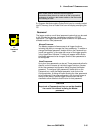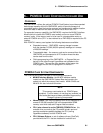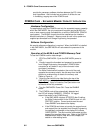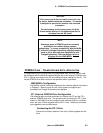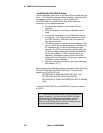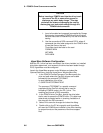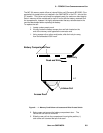
6... PCMCIA CARD CONFIGURATION AND USE
USING THE OMP-MODL6-4
Installing the CardTalk Drivers:
Follow the detailed instructions in the User’s Guide supplied with the
drive. The installation process creates a directory called CardTalk
and copies a number of files into it. It then modifies the
AUTOEXEC.BAT and CONFIG.SYS files. A few additional
comments on this installation process:
♦ Insure that the installation is done from DOS as
specified
♦ Either the Express or the Custom Installation can be
used.
♦ For use with HyperWare, only the SRAM card drivers
are required. (ie at the prompt, do not select to install
the FFS2 drivers for Microsoft Flash File system as
they are not required)
♦ Two different types of parallel port are available on PC’s
today, the EPP (enhanced parallel port) and Standard.
All installations will run with the Standard port type
selected. If a EPP port is available, selecting this type
will provide slightly faster data read/write performance.
During the installation, if EPP is selected but is not
detected, a message will display and the CardTalk
software will not be installed. If this occurs, repeat the
installation choosing Standard.
♦ Specify the correct printer port to use during installation
(the default is LPT1)
Near the end of the installation process, changes will be made to the
PC AUTOEXEC.BAT and CONFIG.SYS files. Three lines are
added to the CONFIG.SYS file:
DEVICEHIGH=C:\CARDTALK\SSPPORT.SYS /lpt:1
DEVICEHIGH=C:\CARDTALK\CTALKCS.EXE
DEVICEHIGH=C:\CARDTALK\CARDTALK.SYS /A /MEMW
/IOW
In the AUTOEXEC.BAT file, the CARDTALK directory is added to
the PATH.
TIP: These drivers are fairly large and will be loaded into
memory at reboot. For Users running DOS 6.0 or later
with the Multiple Configuration boot options, it may be
desirable to set up an optional load of these drivers.
Refer to the DOS Help and/or manual for details on how
to set up the Multiple Configuration boot.



